+ Open data
Open data
- Basic information
Basic information
| Entry | Database: PDB / ID: 2nm1 | ||||||
|---|---|---|---|---|---|---|---|
| Title | Structure of BoNT/B in complex with its protein receptor | ||||||
 Components Components |
| ||||||
 Keywords Keywords | TOXIN / HYDROLASE / neurotransmission / botulism / synaptotagmin | ||||||
| Function / homology |  Function and homology information Function and homology informationToxicity of botulinum toxin type B (botB) / calcium-dependent activation of synaptic vesicle fusion / inositol 1,3,4,5 tetrakisphosphate binding / chromaffin granule membrane / calcium ion sensor activity / regulation of calcium ion-dependent exocytosis / exocytic vesicle / positive regulation of dendrite extension / Cargo recognition for clathrin-mediated endocytosis / Clathrin-mediated endocytosis ...Toxicity of botulinum toxin type B (botB) / calcium-dependent activation of synaptic vesicle fusion / inositol 1,3,4,5 tetrakisphosphate binding / chromaffin granule membrane / calcium ion sensor activity / regulation of calcium ion-dependent exocytosis / exocytic vesicle / positive regulation of dendrite extension / Cargo recognition for clathrin-mediated endocytosis / Clathrin-mediated endocytosis / bontoxilysin / dense core granule / calcium-dependent phospholipid binding / host cell presynaptic membrane / host cell cytoplasmic vesicle / syntaxin binding / host cell cytosol / phosphatidylserine binding / regulation of synaptic vesicle exocytosis / synaptic vesicle exocytosis / protein transmembrane transporter activity / vesicle-mediated transport / SNARE binding / neuromuscular junction / metalloendopeptidase activity / terminal bouton / synaptic vesicle membrane / toxin activity / cell differentiation / axon / calcium ion binding / lipid binding / host cell plasma membrane / proteolysis / extracellular region / zinc ion binding / membrane / plasma membrane Similarity search - Function | ||||||
| Biological species |   | ||||||
| Method |  X-RAY DIFFRACTION / X-RAY DIFFRACTION /  SYNCHROTRON / SYNCHROTRON /  MOLECULAR REPLACEMENT / Resolution: 2.15 Å MOLECULAR REPLACEMENT / Resolution: 2.15 Å | ||||||
 Authors Authors | Jin, R. / Rummel, A. / Binz, T. / Brunger, A.T. | ||||||
 Citation Citation |  Journal: Nature / Year: 2006 Journal: Nature / Year: 2006Title: Botulinum neurotoxin B recognizes its protein receptor with high affinity and specificity. Authors: Jin, R. / Rummel, A. / Binz, T. / Brunger, A.T. #1:  Journal: NAT.STRUCT.BIOL. / Year: 2000 Journal: NAT.STRUCT.BIOL. / Year: 2000Title: Structural analysis of the catalytic and binding sites of Clostridium botulinum neurotoxin B. Authors: Swaminathan, S. / Eswaramoorthy, S. #2:  Journal: Biochem.Biophys.Res.Commun. / Year: 2005 Journal: Biochem.Biophys.Res.Commun. / Year: 2005Title: N-terminal helix reorients in recombinant C-fragment of Clostridium botulinum type B. Authors: Jayaraman, S. / Eswaramoorthy, S. / Ahmed, S.A. / Smith, L.A. / Swaminathan, S. | ||||||
| History |
|
- Structure visualization
Structure visualization
| Structure viewer | Molecule:  Molmil Molmil Jmol/JSmol Jmol/JSmol |
|---|
- Downloads & links
Downloads & links
- Download
Download
| PDBx/mmCIF format |  2nm1.cif.gz 2nm1.cif.gz | 111.2 KB | Display |  PDBx/mmCIF format PDBx/mmCIF format |
|---|---|---|---|---|
| PDB format |  pdb2nm1.ent.gz pdb2nm1.ent.gz | 84.1 KB | Display |  PDB format PDB format |
| PDBx/mmJSON format |  2nm1.json.gz 2nm1.json.gz | Tree view |  PDBx/mmJSON format PDBx/mmJSON format | |
| Others |  Other downloads Other downloads |
-Validation report
| Summary document |  2nm1_validation.pdf.gz 2nm1_validation.pdf.gz | 434.4 KB | Display |  wwPDB validaton report wwPDB validaton report |
|---|---|---|---|---|
| Full document |  2nm1_full_validation.pdf.gz 2nm1_full_validation.pdf.gz | 447.5 KB | Display | |
| Data in XML |  2nm1_validation.xml.gz 2nm1_validation.xml.gz | 20.1 KB | Display | |
| Data in CIF |  2nm1_validation.cif.gz 2nm1_validation.cif.gz | 27.8 KB | Display | |
| Arichive directory |  https://data.pdbj.org/pub/pdb/validation_reports/nm/2nm1 https://data.pdbj.org/pub/pdb/validation_reports/nm/2nm1 ftp://data.pdbj.org/pub/pdb/validation_reports/nm/2nm1 ftp://data.pdbj.org/pub/pdb/validation_reports/nm/2nm1 | HTTPS FTP |
-Related structure data
| Related structure data |  1z0hS S: Starting model for refinement |
|---|---|
| Similar structure data |
- Links
Links
- Assembly
Assembly
| Deposited unit | 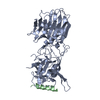
| ||||||||
|---|---|---|---|---|---|---|---|---|---|
| 1 |
| ||||||||
| Unit cell |
|
- Components
Components
| #1: Protein | Mass: 52403.988 Da / Num. of mol.: 1 / Fragment: receptor binding domain Source method: isolated from a genetically manipulated source Source: (gene. exp.)   |
|---|---|
| #2: Protein/peptide | Mass: 2121.454 Da / Num. of mol.: 1 / Fragment: luminal domain Source method: isolated from a genetically manipulated source Source: (gene. exp.)   |
| #3: Water | ChemComp-HOH / |
-Experimental details
-Experiment
| Experiment | Method:  X-RAY DIFFRACTION / Number of used crystals: 1 X-RAY DIFFRACTION / Number of used crystals: 1 |
|---|
- Sample preparation
Sample preparation
| Crystal | Density Matthews: 2.83 Å3/Da / Density % sol: 56.6 % |
|---|---|
| Crystal grow | Temperature: 293 K / Method: evaporation / pH: 7 Details: 13% PEG 6000, 0.1M Hepes, pH 7.0, EVAPORATION, temperature 293K |
-Data collection
| Diffraction | Mean temperature: 100 K |
|---|---|
| Diffraction source | Source:  SYNCHROTRON / Site: SYNCHROTRON / Site:  ALS ALS  / Beamline: 8.2.2 / Wavelength: 1 / Beamline: 8.2.2 / Wavelength: 1 |
| Detector | Type: ADSC QUANTUM 315 / Detector: CCD / Date: Jun 9, 2006 |
| Radiation | Protocol: SINGLE WAVELENGTH / Monochromatic (M) / Laue (L): M / Scattering type: x-ray |
| Radiation wavelength | Wavelength: 1 Å / Relative weight: 1 |
| Reflection | Resolution: 2.15→40 Å / Num. all: 32540 / Num. obs: 32377 / % possible obs: 99.5 % / Observed criterion σ(F): 0 / Observed criterion σ(I): 0 / Redundancy: 7 % / Biso Wilson estimate: 21.4 Å2 / Rmerge(I) obs: 0.076 / Net I/σ(I): 12.9 |
| Reflection shell | Resolution: 2.15→2.23 Å / Rmerge(I) obs: 0.507 / Mean I/σ(I) obs: 3 / % possible all: 96.1 |
- Processing
Processing
| Software |
| ||||||||||||||||||||||||||||||||||||
|---|---|---|---|---|---|---|---|---|---|---|---|---|---|---|---|---|---|---|---|---|---|---|---|---|---|---|---|---|---|---|---|---|---|---|---|---|---|
| Refinement | Method to determine structure:  MOLECULAR REPLACEMENT MOLECULAR REPLACEMENTStarting model: PDB entry 1Z0H Resolution: 2.15→39.81 Å / Rfactor Rfree error: 0.006 / Data cutoff high absF: 88482.92 / Data cutoff low absF: 0 / Isotropic thermal model: RESTRAINED / Cross valid method: THROUGHOUT / σ(F): 0 / Stereochemistry target values: Engh & Huber
| ||||||||||||||||||||||||||||||||||||
| Solvent computation | Solvent model: FLAT MODEL / Bsol: 44.8303 Å2 / ksol: 0.337789 e/Å3 | ||||||||||||||||||||||||||||||||||||
| Displacement parameters | Biso mean: 44.5 Å2
| ||||||||||||||||||||||||||||||||||||
| Refine analyze |
| ||||||||||||||||||||||||||||||||||||
| Refinement step | Cycle: LAST / Resolution: 2.15→39.81 Å
| ||||||||||||||||||||||||||||||||||||
| Refine LS restraints |
| ||||||||||||||||||||||||||||||||||||
| LS refinement shell | Resolution: 2.15→2.28 Å / Rfactor Rfree error: 0.02 / Total num. of bins used: 6
| ||||||||||||||||||||||||||||||||||||
| Xplor file |
|
 Movie
Movie Controller
Controller




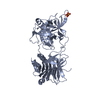

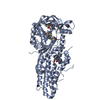
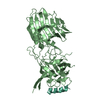

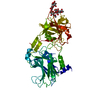
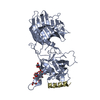
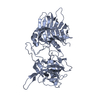
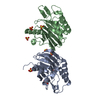

 PDBj
PDBj





